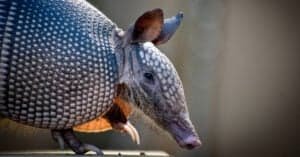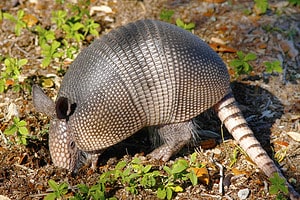Armadillos are cat-sized mammals with bony, scaled shells. Commonly found in Central America, South America, and the United States, armadillos are naturally susceptible to various human diseases, including leprosy. That being said, while armadillos are not necessarily dangerous to humans in terms of violent attacks, they can spread deadly illnesses. This has been a common concern for Florida residents, as armadillos in Florida can cause some major problems.
Armadillos are especially common in southwestern states, but they recently have made their way to Florida and other portions of the east coast (specifically the species nine-banded armadillos, which are the only species in the U.S.) Keep reading to learn more about where you can find armadillos in Florida and some common problems they cause.
Most Common Regions
Throughout Florida, you can find armadillos roaming in areas like forests and semi-open habitats. In fact, they are relatively common throughout most regions of the state. Florida officials even consider armadillos naturalized in Florida, meaning they now live wild in the region and have established a home base there.

Nine-banded armadillos often frequent the Florida wetlands.
©iStock.com/Saddako
Armadillos prefer areas that allow them to dig easily, as this animal creates burrows for their homes and to escape predators. They are most commonly active at night, so you might miss them during the day. However, there are some telltale signs of armadillos in your yard or property, as you will find evidence of burrows and potentially even dug-up flowerbeds.
3 Problems Armadillos Cause
Armadillos themselves are not dangerous, but they can cause dangerous problems and nuisances. While they likely won’t bite or attack, they do have the potential to spread diseases and ruin properties. Here are three problems with having armadillos on your property.
Armadillos Carry Diseases
Unfortunately, armadillos carry severe and dangerous diseases, including St. Louis encephalitis, leptospires, arboviruses, and leprosy.
Specifically in the southern portions of the United States, some armadillos carry the bacteria that causes Hansen’s disease, which is another name for leprosy. Thankfully, according to the CDC, the risk of an armadillo spreading this disease to a human is very low. In fact, most people who come into contact with armadillos will generally remain healthy and safe.
That being said, it’s still important to avoid contact at all means. If you do end up coming into contact with an armadillo, be sure you practice good sanitary practices and visit a healthcare provider who can monitor you for any concerning symptoms.
Additionally, keep young children and pets away from armadillos. If you notice signs of armadillos in your yard, take action immediately so you don’t expose yourself or your loved ones to this threat.
Armadillos Might Damage Lawns and Properties
As mentioned earlier, armadillos will often dig burrows for comfort and protection. These little holes act as their homes and keep them safe from predators. Oftentimes, armadillos will dig numerous borrows with multiple entrances. If an armadillo finds its way to your property, it might turn your yard into its own underground territory. This might look like several holes in your lawn, dug-up grass, and scattered dirt all over your property, which can be a hassle to fix and clean.

Armadillos are relatively fast.
©mariamalaya/Shutterstock.com
Unfortunately, your lawn isn’t the only thing you have to worry about either. Many armadillos will carry out their tunneling behaviors under foundations and driveways, which can cause irreversible damage. For instance, you might begin to notice cracks in your driveway as a result of insistent digging. On the other hand, an armadillo digging can wreak havoc on the aesthetics of your home’s exterior. In fact, armadillos can even do critical damage to underground pipes, cables, structural foundations, and more.
Armadillos Can Uproot Plants and Flower Beds
Just as they can dig up your lawn, armadillos will often dig up gardens, too. In fact, they might even uproot your plants and flowerbeds, killing the vegetation and landscaping you have been working tirelessly to grow.
Though armadillos eat insects and other vertebrates that could be harmful to your garden, these animals are more of a nuisance than a benefit. Additionally, since they carry dangerous diseases, you won’t want your armadillos anywhere near your vegetation.
Treating Your Armadillos Problem
There are many ways you can get rid of armadillos in your yard. For one thing, you can install inground fencing or electric fencing to keep armadillos out of your property. You can also try natural remedies to deter armadillos. Finally, if that doesn’t work or isn’t an option for you, you can consider live trapping, which is lawful in Florida.
According to the Florida legal code:
“All live-captured nuisance armadillos must be euthanized, released on-site, or released on a property within the same county of capture, that is 40 acres or larger with written permission from the landowner. However, relocating wildlife is seldom biologically sound and the animal often does not survive. Captured non-target species are required to be released on site.”
The photo featured at the top of this post is © Klaus Balzano/Shutterstock.com
Thank you for reading! Have some feedback for us? Contact the AZ Animals editorial team.







